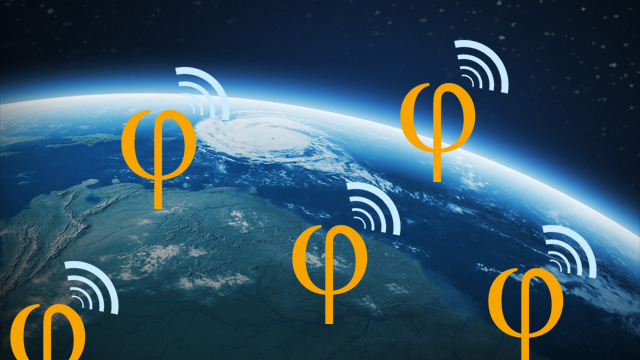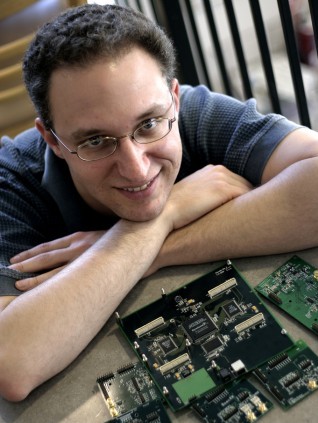
In 1976, two shaggy-haired college dropouts founded a company called Apple to manufacture personal computers. The company's prospects looked so poor that the third co-founder relinquished his 10 percent stake in the company for $800 that same year. It simply wasn't clear why anyone would want the firm's Apple I computer. It was so under-powered that it couldn't perform many of the functions of mainframes and minicomputers that were already on the market. And most consumers had no interest in having a computer in their homes.
Today, of course, Apple is the world's largest company by market capitalization. What was important about the Apple I wasn't the meager capabilities of the original version, but the promise it held for rapid innovation in the coming decades.
Now, a company called Per Vices hopes to do for wireless communication what Apple did for computing. It is selling software-defined radio gear called the Phi that, like the Apple I, is likely to be of little interest to the average consumer (it was even briefly priced at the same point as the Apple I, $666.66, but has since been placed at $750). But the device, and others like it, has the potential to transform the wireless industry. This time, the revolution will depend on hackers enabled to manipulate radio signals in software.
The versatility of software-defined radio
Traditional radio chips are hard-wired to communicate using one specific protocol. For example, a typical cell phone has several different chips to handle a variety of radio communications: one to talk to cell phone towers, another to contact WiFi base stations, a third to receive GPS signals, and a fourth to communicate with Bluetooth devices. In contrast, software-defined radio hardware works with raw electromagnetic signals, relying on software to implement specific applications.
This makes software-defined radio devices tremendously versatile. With the right software, a single software-defined radio chip could perform the functions of all of those special-purpose radio chips in your cell phone and many others besides. It could record FM radio and digital television signals, read RFID chips, track ship locations, or do radio astronomy. In principle it could perform all of these functions simultaneously. Software-defined radio hardware also enables rapid prototyping of new communications protocols.
Software-defined radio will make it possible to use the electromagnetic spectrum in fundamentally new ways. Most radio standards today are designed to use a fixed, narrow frequency band. In contrast, software-defined radio devices can tune into many different frequencies simultaneously, making possible communications schemes that wouldn't be feasible with conventional radio gear.
Most significantly, the widespread adoption of software-defined radio hardware could undermine the FCC's control over the electromagnetic spectrum itself. Right now, the FCC largely focuses on limiting the transmission frequencies of radio hardware. But this regulatory approach is likely to work poorly for software-defined radio devices that aren't confined to any specific frequency.
The effective deregulation of the airwaves could create headaches as careless hobbyists pollute frequency bands that have been reserved for other applications. But it's also likely to usher in an era of unprecedented radio innovation as millions of people have the opportunity to experiment with technologies that, until recently, were the exclusive domain of well-funded industrial labs.
The pioneers
Software-defined radio has had political undertones since its inception. A decade ago, some early software radio enthusiasts became interested in the "broadcast flag" debate then raging in Washington. Hollywood wanted to force consumer electronics companies to detect and comply with metadata in HDTV broadcasts that would signal what consumers were allowed to do with television content.
Eric Blossom, founder of a software project called GNU Radio, hoped that implementing an HDTV receiver in software and releasing it as open source would demonstrate the futility of this approach. Even if the government forced his project to implement the broadcast flag, he argued, anyone could tweak the source to disable the broadcast flag code and then re-compile it.

The effort to build a software receiver for the ATSC television format was ultimately successful. "We would record samples off the air, then process them in our app in GNU radio, and you could watch the MPEG of Law and Order," Matt Ettus, a contributor to the effort, told us.
Ettus said the hardware used to build the ATSC receiver "wasn't something that someone else could go out and buy." Also, it "wasn't well set up for what we were doing." It could only capture a narrow slice of spectrum: 100 kHz at most. That was enough for Law and Order reruns, but Ettus believed better hardware would be needed to unleash the full potential of software-defined radio technology.
"To do more interesting things you need more hardware," Ettus said. He wanted to capture a much wider range of frequencies. And he wanted other advanced features like the ability to handle multiple antennas simultaneously.
The USRP
"I went a long time trying to convince somebody else to build this thing and nobody would," Ettus told us. So in 2003, he began work on what became the Universal Software Radio Peripheral (USRP). In 2004, he quit his job as an engineer working on conventional radio products to focus on the USRP full-time, shipping his first unit on January 1, 2005.
Today, Ettus Research builds a range of devices specifically designed for software-defined radio. A working USRP system comes in three parts: the main USRP box, an RF daughterboard, and a computer. The daughterboard handles the actual reception of radio signals, and passes the analog signal to the main USRP unit. Ettus explained to us what happens from there.
"First it converts the analog signal to digital. Then the digital signal is sent to a field-programmable gate array. The FPGA does the high-speed processing and the user can modify it and put all sorts of interesting things in there. In the most basic configuration, the FPGA reduces the sample rate, does some frequency translation, and then sends that out over the interface" to the CPU.
The interface that connects the USRP to the computer is the main thing that distinguishes the various USRP models from each other. The cheapest model (costing $650) delivers the data to the user's computer over a relatively slow USB link. The priciest model (costing $1700) has a gigabit Ethernet interface. In between, the company offers an "embedded" model that includes a built-in CPU capable of running a full Linux distribution, which allows it to function as a stand-alone device.
Each RF daughterboard is designed to receive a different range of frequencies. "We used to need a lot of different daughterboards to cover an interesting frequency range," he told us. "When we first started, you could only get a couple hundred MHz with decent performance. But as technology advanced, we've gotten newer and newer daughterboards with wider range."
Ettus said one of the most interesting applications for the USRP has been for open source cell phone telephony. Users have configured USRPs to provide GSM cellular service, deploying them "in a number of places, from Burning Man to small islands in the Pacific." The hackability of the USRP makes it more versatile than traditional cellular gear, making it ideal for unusual environments.
Wireless security research is another key application for the USRP. For example, one research group used a USRP to discover security vulnerabilities in the wireless communications protocol of a commercially available pacemaker. "If you want to determine wireless security, you need to be able to send those devices interesting packets," he said. "You need complete control of the packets you send, and you need to examine the received packets at a fundamental level." Conventional wireless hardware can't match the flexibility of software-defined radio hardware for this kind of application.
reader comments
90